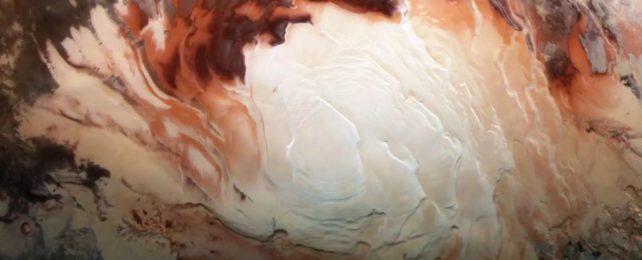What scientists thought were lakes of liquid water hiding under the southern polar ice cap of Mars could turn out to be… just regular old rock.
New analysis has found that the brightly shining radar signal interpreted as underground water on the red planet could also have been produced by geological layering. It's not a foregone conclusion, but it does suggest that stronger evidence is needed before we can determine with any certainty what's lurking under there.
"Here we demonstrate that similar reflections can be generated as the natural result of thin layer interference, without invoking any liquid water or otherwise rare materials," write a team of researchers led by astronomer Dan Lalich of Cornell University in a new paper.
"This result, combined with other recent work, calls into question the likelihood of finding liquid water below the south polar layered deposit (SPLD)."
The mysterious signal was first detected a few years ago, in radar data collected by the European Space Agency's Mars Express satellite probe. There, buried beneath the Martian southern polar ice cap, scientists spotted a patch of unusually reflective material.
Subsequent searches yielded more brightly shining underground patches, suggesting that whatever the first patch was, it definitely wasn't unique.
Even more excitingly, similar shining patches had been found right here on Earth – also buried under the ice of the South Pole. These are the subglacial lakes, such as Lake Vostok, that make up a network of liquid reservoirs under the Antarctic ice.
This led scientists to the conclusion that there could be similar liquid reservoirs on Mars. There's just one catch: Mars is thought to be too cold for liquid water, even pressurized under layers of ice, and with a freezing point lowered by the presence of salts.
So, what are the shiny patches? To investigate, Lalich and colleagues conducted simulations using a layering of four materials known to occur on Mars.
Ground-penetrating radar works by bouncing radio waves at an object or surface. How long it takes for those radio waves to be reflected back, and how strongly, reveals the properties of the materials below the surface of a planet – but not necessarily what those materials are.
The researchers created simulated layers of water ice, carbon dioxide ice, basalt and atmosphere in a variety of configurations and thicknesses, each with properties that reflect radar pulses in specific ways.
Then, they worked out what signals these configurations would produce. And they got something just as bright as the Mars Express observations: a layer of dusty water ice sandwiched between two layers of carbon dioxide ice.
"I used CO2 layers embedded within the water ice because we know it already exists in large quantities near the surface of the ice cap," Lalich explains.
"In principle, though, I could have used rock layers or even particularly dusty water ice and I would have gotten similar results. The point of this paper is really that the composition of the basal layers is less important than the layer thicknesses and separations."
This is not the only recent suggestion that the shimmery signal could have been generated by something that's not liquid water. A team last year found that frozen clays produce the same level of radar shine, and earlier this year, another team proposed volcanic rock (which Mars has in abundance) as a source.
With the addition of layers of rock and/or ice, which are more consistent with what we know about Mars, the water explanation seems to be receding farther from likelihood.
Which would be a shame, because liquid water on Mars would have implications for its past and maybe even present habitability, as well as future crewed missions to the red planet.
But it's also possible that we'll never actually know for sure.
"None of the work we've done disproves the possible existence of liquid water down there," Lalich says. "We just think the interference hypothesis is more consistent with other observations. I'm not sure anything short of a drill could prove either side of this debate definitively right or wrong."
Which, given the depth of the patches, the distance to Mars, and the difficulty of transporting things there (especially heavy drilling machinery), is not likely to happen any time soon.
The team's research has been published in Nature Astronomy.
